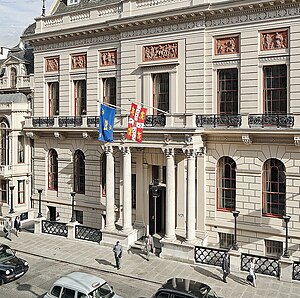William Grinsell Nicholl




William Grinsell Nicholl (London 1796–1871) was a British 19th-century architectural and monumental sculptor.
Life[]
He was born in Marylebone, London in 1796. In 1822 he attended the Royal Academy Schools.[1]
He exhibited in the Royal Academy from 1822 to 1861 and was highly respected. His studio was on Grafton Street East - off Totteham Court Road, London
He died in Acton in west London on 8 December 1871.[2]
Architectural Works[]
- London Customs House (1827) - entablature as part of rebuilding after partial collapse
- Portico and columns of the Fitzwilliam Museum, Cambridge (1830-1837) - under George Basevi and designed by Charles Lock Eastlake
- Bas-reliefs over windows at the Oxford and Cambridge Club in London (1838) - under Sir Robert Smirke
- Four lions[3] at foot of stairs, Fitzwilliam Museum (1839)[4]
- Pediment of the Taylor Institute in Oxford (1846)[5]
- Pediment and columns of St George's Hall, Liverpool (1850) - under Charles Robert Cockerell
- Four lions at St George's Hall, Liverpool (1855)[6]
- Reredos at Waltham Abbey Church (1862)[7] under William Burges
- Lectern at Worcester College Chapel, Oxford University (1866)
Other Works[]
- Bust of Henry Sass (1820) -possibly as Nicholl's tutor
- Bust of George III (c.1822) copy of Jubilee Bust by Peter Turnerelli[8]
- Bust of John Law, Archdeacon of Rochester (1827), Chatham Parish Church[9]
- Bust of Philip Rundell (1827) now in Victoria and Albert Museum[10]
- Statue of Captain Cook (1844) Royal Academy
- Monument to Sir John Hippisley (1825) Temple Church, Inner Temple, London. Destroyed in the Blitz.
- Monument to John Frewen-Turner (1829) Cold Overton, Leicestershire
- Monument to (1830) at Minster, Kent
- Monument to Sir George Don (1832) in Garrison Church, Gibraltar (now the Anglican Cathedral).
- Monument to Joseph Bonsor(1835) Great Bookham parish church, Surrey
- Monument to Elizabeth Morley (1837) Walthamstow Parish Church[11]
- Monument to Richard Stevenson (1837) Trinity College Chapel, Cambridge
- Monument to Rev J. Murray (1862) St Andrews Church, Wells Street, London. The church was demolished and rebuilt in 1933–4 as St Andrew’s, Kingsbury.[12]
- Medallions, bas relief carvings and architectural details in the Octagon room of the Garden Pavilion in the Grounds of Buckingham Palace (1846).[13] Pavillion removed (1928)
- Statues of Lord Cornwallis[14]at the India Office,London.</ref> and Clive[15]at the India Office,London.</ref> (1867)
Family[]
He married Emma Elizabeth Nicholson in Paddington, London, on 17 April 1821. Between 1851 and 1854 they lived with most of their children in Sydney, Australia. Nicholl's second daughter, Charlotte Anne (1824-1905) married John Russell, an iron founder, 17 February 1855 in St James Church, Sydney and their son John Peter Russell the Australian impressionist painter was born in 1858.
References[]
- ^ "William Grinsell Nicholl - Mapping the Practice and Profession of Sculpture in Britain and Ireland 1851-1951".
- ^ Dictionary of British Sculptors 1660-1851 by Rupert Gunnis
- ^ https://commons.wikimedia.org/wiki/Category:Lions_on_St_George's_Plateau,
- ^ Architectural History of Cambridgevol3 p.210
- ^ Builder (journal) 1846 p.505
- ^ "31 Liverpool statues and the true stories behind them". 14 July 2019.
- ^ Builder (journal) 1862 p.499
- ^ "Philip Mould | Historical Portraits | King George III %7C William Grinsell Nicholl | Item Details".
- ^ "William Grinsell Nicholl (1796-1871)".
- ^ "Philip Rundell (1743-1827) | Nicholl, William Grinsell | V&A Explore the Collections".
- ^ "Walthamstow: Churches | British History Online".
- ^ "St Andrew's Church, formerly in Wells Street, now at Kingsbury, Middlesex | UCL the Survey of London".
- ^ Jameson, Anna. Introduction to The decorations of the garden-pavilion in the grounds of Buckingham palace. Ed. Ludwig Grüner. London: John Murray, 1846.
- ^ A descriptive Catalogue of the Paintings, Statues etc. in the India Office by William Foster (1924)
- ^ A descriptive Catalogue of the Paintings, Statues etc. in the India Office by William Foster (1924)
- 1796 births
- 1871 deaths
- People from Marylebone
- British sculptors